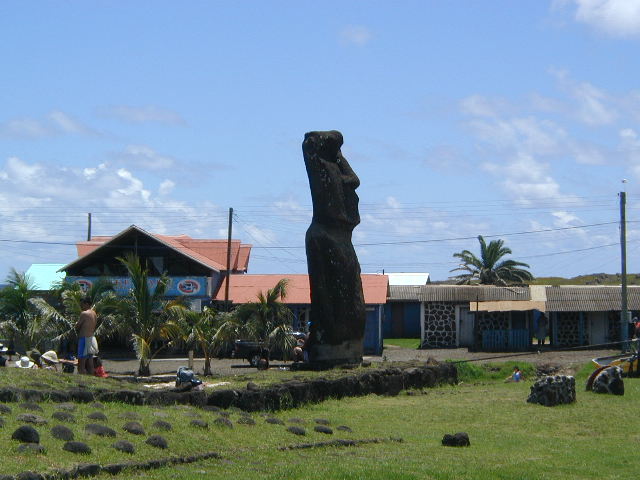
Lan Chile lets you check in on line 48 hours before your flight and I took advantage of that via the computers in their Providencia office. So all I had to do at the airport was drop off my baggage and make my way to the gate. While waiting for the flight, I chatted with several other people on their way to Rapa Nui. Aside from excursions like mine, the other common itinerary is to stop there and Tahiti on the way from South America to New Zealand.
At any rate, Lan's service was excellent, even in coach, with confortable seats and a reasonably wide choice of movies. I had been wondering how to find out details for the Tapati festival and Lan solved that problem nicely by handing out the festival programs on the plane. It took a while for my bag to show up at the other end, but it did make it and I set out to find Edith, who (with her husband, Bill) owns the Hotel Tau Ra'a. The hotel is in the heart of Hanga Roa (the only actual town on the island), making it quite convenient. But I'd really made my choice based on reviews in a couple of guide books (and on-line) and it was a good one. The room was large, clean, and comfortable. There's no air conditioning, but the ceiling fan was perfectly adequate, especially as things cooled off quite a bit at night. One of the other benefits of staying there was a good cooked breakfast, which was also a fine opportunity to mingle with other tourists.
One doesn't really want to wait before seeing the famous statues and, fortunately, there's Ahu Tatira, right at the harbor in Hanga Roa.

This is as good a time as any to explain that an ahu is an altar and moai are the statues on the altar. Contrary to popular belief, the moai are not simply giant heads - they also have torsos and arms and some even have details like fingernails. Some later ones have the added feature of pukao, topknots that are believed to resemble a hairstyle of the time. Almost all of the moai were toppled by the 19th century, so any you see standing have been restored. Several of my friends asked how old the moai are. I don't have a definitive answer, but my best guess is on the order of 1000 years old.
Not a lot is open in Hanga Roa on the weekend, but I watched a bit of an outrigger canoe race, which I think was part of the festival regatta. Closer in, there were boys surfing at the beach. Just wandering around town was pleasant enough, though it was very hot and humid out. The church was a good place to get out of the heat and has some interesting carvings. Only a few vendors at the crafts market next to the church were there, however, and I decided my shopping would need to wait. I was also surprised by the number of horses wandering around, both with and without riders. There are also lots of stray dogs - something common throughout Chile and attributed to the Latin macho culture's dislike of the thought of cutting the cojones off any creature. The dogs seem to be well fed and not aggressive, so they're not really a problem, but are noticeable.
I'll note there that pretty much everything is twice as expensive on Rapa Nui as on the mainland. That makes sense for food (including bottled water), which all has to be brought in. I assume the higher prices for things like internet access are the indirect result, given the higher living costs of the island. I'll also mention that the best options for food run to grilled seafood. A dinner of, say, a tuna steak with rice or taro will run you about CLP 8000, so it isn't a particular bargain. If you're looking for cheaper stuff, any number of grills cook skewered meat (Polynesian shish kebab!) at the Tepati festival. Or you can stop at an empanda stand for a quick snack.
I took two tours, both of them arranged by the hotel. The first of these was the West Coast tour, which started with Ana Kai Tangata. This is a large cave, with cave paintings inside relating to the birdman cult (which I will discuss more later).
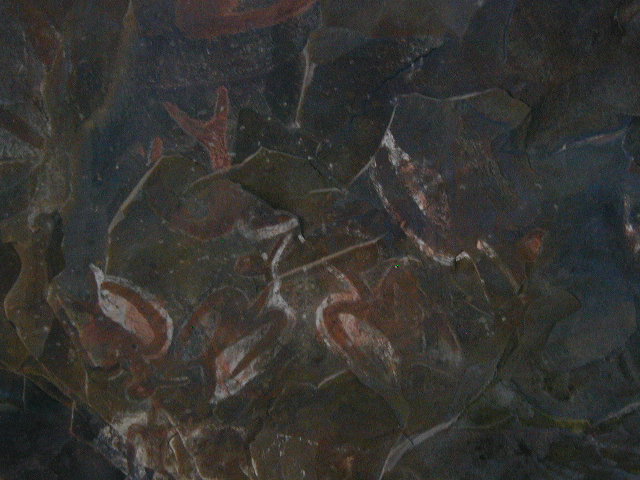
The view out from the cave was more spectacular than the paintings, however.
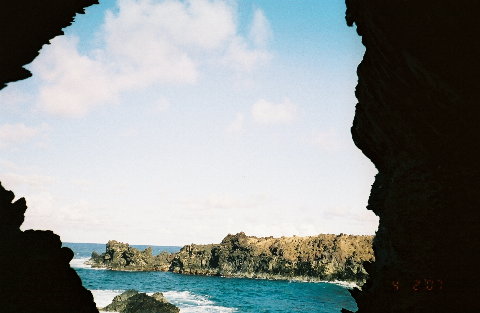
We stopped briefly at the rim of Ranu Kau. This is one of the three extinct volcanos which formed the island. The bottom of the crater has a lake with thick reeds growing in it.
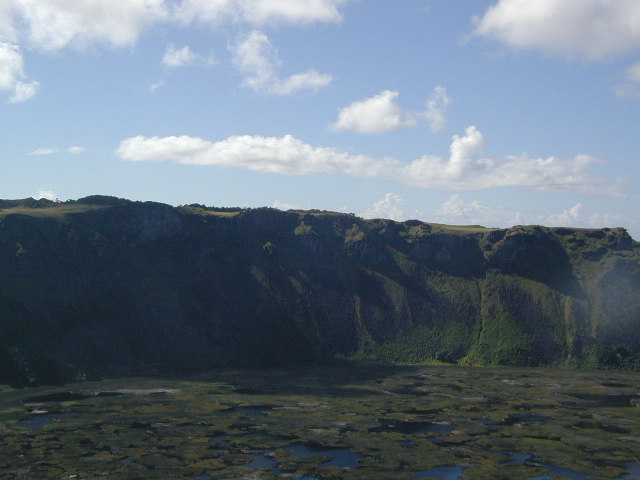
The highlight of the tour was Orongo Ceremonial Village. This is the only one of the archaeological sites to charge an admission fee - USD 10 or CLP 5000. There is a path around the site, taking you past rebuilt stone houses with thick walls. The major interest there, however, is the birdman cult. This apparently replaced the earlier beliefs involving the moai and continued well into the 19th century. Each of six clans had a representative who climbed down the cliff and swam out to the small off-shore islands where the sooty terns nest. The first one to find an egg and bring it back won his clan's leader the status of birdman, which carried various obscure privileges. There was also a bride involved as a prize and you can go up on the roof of a house, which was her balcony. That's where the famous boulders covered with birdman petroglyphs are. With the islands in the distance, it's one of the iconic pictures of Rapa Nui.
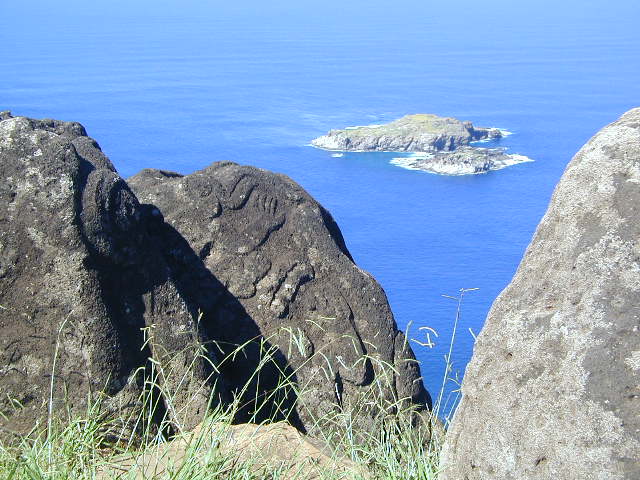
Our next stop was at Vinapu where there are two ahus. One has fine stone work and the theory is that it was a later one, built by Peruvians who came to the island. But there are other claims that it's the original and the second one is a later, inferior copy. Since I made my notes back at the hotel in the evening, I could be wrong, but I think that's also where we saw this remnant of a moai.
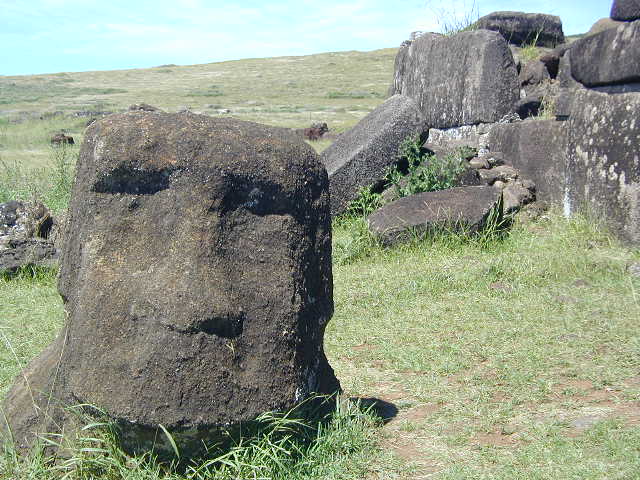
We stopped briefly at a spot which provided a view over pretty much the whole island before continuing on to Puna Pau. This is the place where the red scoria, used to make the pukao (topknots) on some moai, came from. There were several pukau there, but, frankly, I don't find them particularly photogenic lying on the ground.
Ahu Akivi finally provided a spot where there was a photogenic group of moai. There are seven there, which were raised around 1960. The site is unusual because the moai face the sea. The dominant theory is that this is because the site was inland and they still faced the village. But there are also claims that they may have served some sort of astronomical purpose.
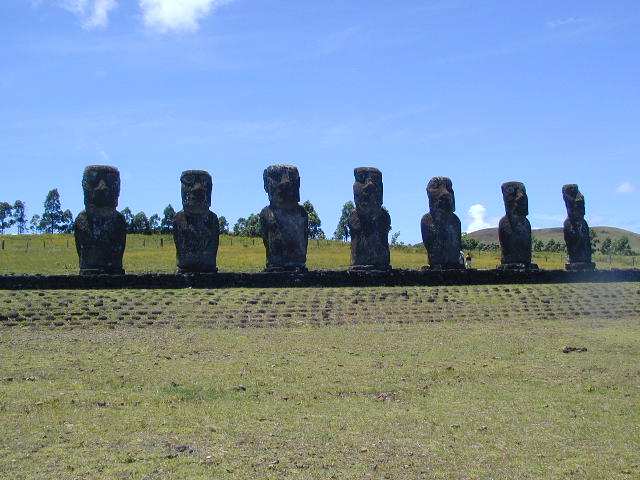
We continued on the Ana Te Pahu, a lava tube cave with a lush garden (taro, sweet potatoes and the like). Then came Ahu Tepeu, which has a number of fallen moai.
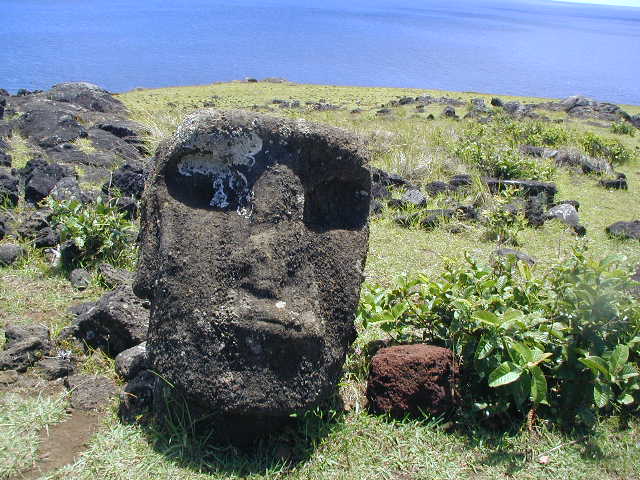
This site was also notable for several "boat houses." These are offically called "hare paenga" and are foundations of long narrow houses, in the shape of a boat. The entrance was somewhere in the middle and they were too low for people to stand up in. Since there are only foundations, I'm not sure how anybody knows how tall they were, but it is fairly obvious that they were not the most luxurious dwelling places around.
The final stop on the tour was Ana Kaakenga. This is another cave and is known for having two windows, i.e. large openings with views to the sea. I opted to spare my knees the descent, so I can't tell you what the views are like.
On arriving back at the hotel, the guide arranged taxis for those of us who were interested in going to see one of the major festival events - the banana sled race. This is held on a steep hill in the north of the island. Men make sleds out of two banana tree trunks lashed together and hurtle down the 45 degree inclination - sort of like luge on dry land. Apparently, if it's rained and the track is wet, it can be quite dangerous, but they seemed to get up a good speed even on the dry slope. The real highlight of the race for me, though, was seeing the elaborate body paint the racers wear.
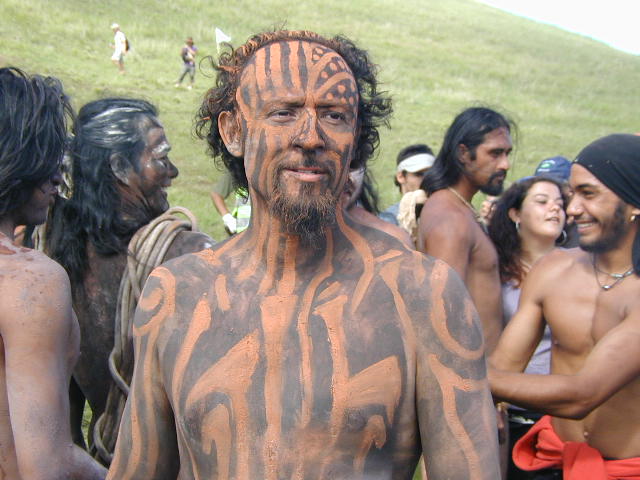
While we were waiting for the taxis to return for us, we saw a crew from The Discovery Channel filming a show about the island. They asked if any of us were willing to be interviewed. I and one other person volunteered. Of course, television cameras lower your IQ bout 50 points, so I'm sure I sounded quite dull. They asked why I'd come to Easter Island and how I'd describe the moai to someone who'd never seen them and so on. I doubt that much of the interview will survive the cutting room floor, but I'm still planning to keep my eyes open for the eventual documentary.
There hadn't been anywhere to have lunch during the tour, so I was pretty hungry when we got back to town. I found a small place that was one of the few that was open on Sunday and got into a conversation with a German woman and Norwegian man who were eating there. The Norwegian man had a guitar and got into an impromptu jam session with a local man who came in, making things quite entertaining. After that broke up, I walked over to the harbor and watched the sun set over Ahu O'Rongo.
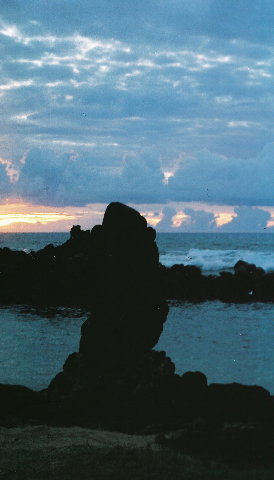
I also went over to the evening portion of the festival, which included part of the traditional dance competition. While it was interesting to watch, it was very crowded. Between that and being tired, I only watched the first couple of presentations before heading back to the hotel.
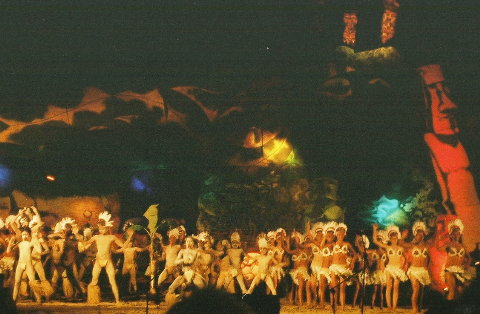
My next day's sightseeing was the South Coast tour, which was guided by Bill. The first stop was Ahu Vaihu, which had a large number of fallen moai. Bill explained that King Hotu Matua, the original settler of the island, had several sons and each clan was descended from one son and controlled one sector of the island. The large ahus are essentially the capitals of each sector. Bill also pointed out a place where a fresh water spring comes out into the sea. Natives were able to drink fresh water from it by putting their heads under water. When early European explorers saw this, they concluded that the Rapa Nui people were able to drink salt water.
We continued on to Ahu Akahonga. This is a large site with boat houses, a couple of ahus, fallen moais, and so on. While we were there, Bill talked about the Long Ears and the Short Ears. The Long Ears extended their ears by piercing them and putting weights in the slits. They were powerful and dominated the Short Ears until the latter group rebelled and killed all the Long Ears. There's also at least some evidence of cannibalism. At any rate, it's these clan wars which probably led to the moai being toppled.
The major site of the tour was Rano Raraku. This is the quarry where the moai were carved and the slope of the volcano is covered with moai. One striking thing is how different they are from one another. For example, there's one who is kneeling. As you can see, he's in protective custody to keep people from sitting on his knees.
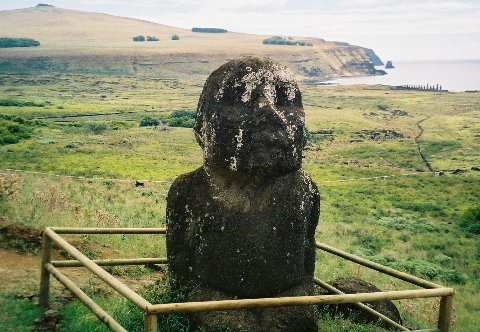
But you see mostly the iconic giant stone heads.
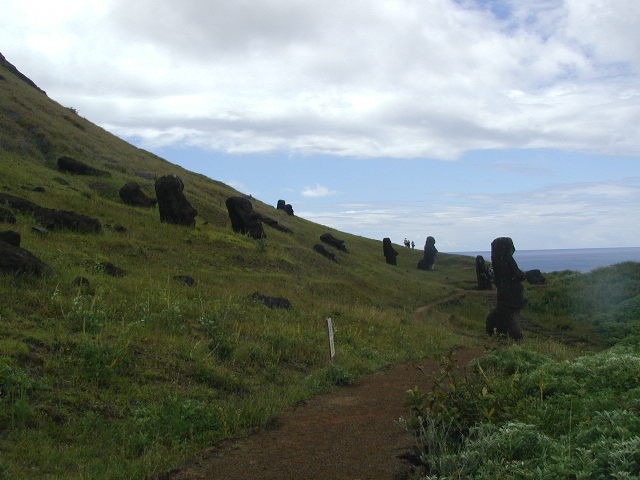
These two are the most photographed moai, partly because they nicely frame tourists standing between them.
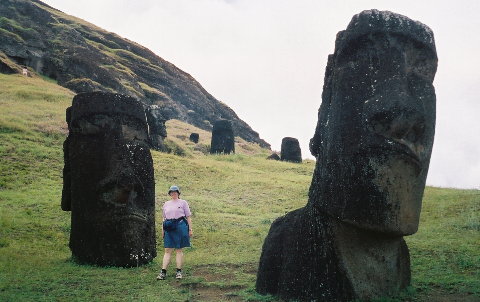
I should note that all of the moai at Rano Raraku are incomplete, as eye sockets were the last thing carved and the eyes (made of coral) were put in after the were erected on an ahu. Bill discussed the various theories of how the moai were moved. The local legend is that they walked from the quarry to their sites. Archaeologists favor various schemes involving skids (made of tree trunks) and ropes. But there are even proponents of an assist from space aliens.
The largest ahu is Ahu Tangariki. When we got to that site, we looked first at petroglyphs near the road, which included birdman and tuna figures. Then we went over to the ahu itself, which has 15 moai on it. Apparently, they were toppled by a tsunami in 1960. A Japanese company re-erected the moai in the 1990's, using German photos from early in the century to determine which one went where.
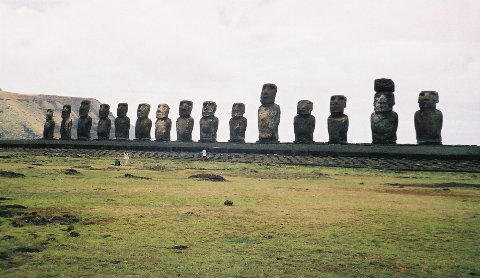
We stopped briefly at Ahu Te Pito Kura. This was the largest ahu, but the moai there have not been re-erected. The name means "the navel of the world" and there's a round magnetic stone that is the actual "navel." By the way, Te Pito Kura was the name the natives originally used for the island, while the term Rapa Nui referred just to the people.
Our final stop of the tour was at Anakena, which is unusual for its lovely beach and its palm trees. It also has snack stands and toilets, by the way.
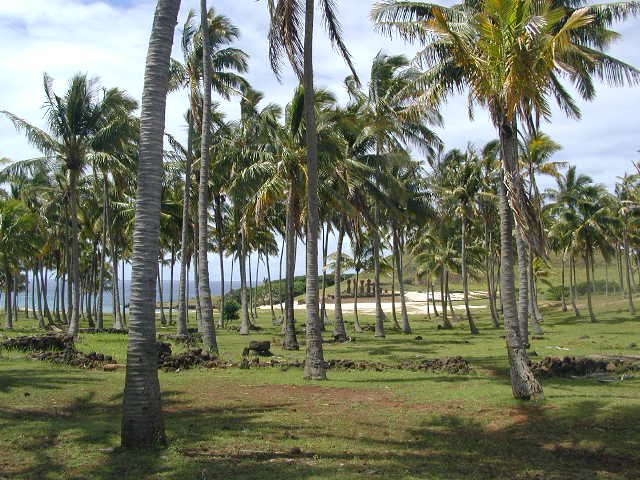
There are a couple of ahu at the beach, including one with a single moai that was reerected by Thor Heyerdahl. The larger ahu has seven moai.
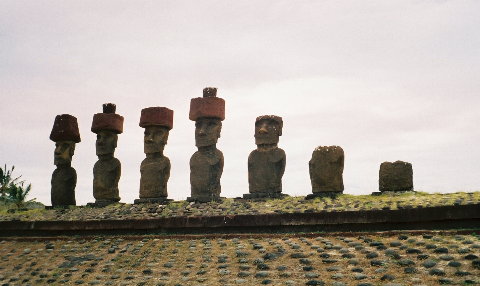
One of the more intriguing things here is the back of the ahu, which includes a stone with a face carved in it.
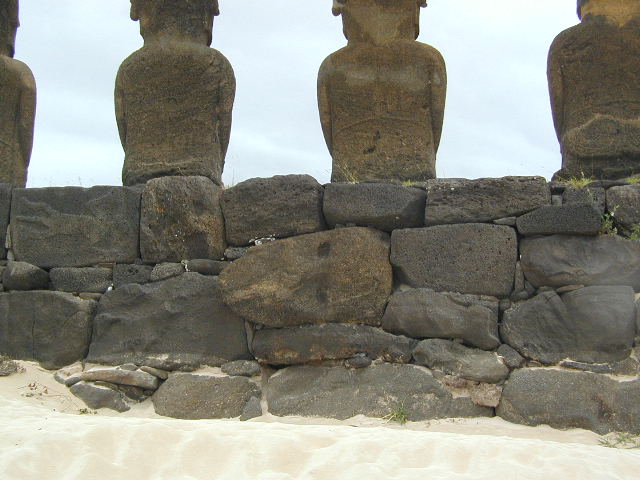
By the way, Anakena is the traditional landing site of Hotu Matua, the first settler of Rapa Nuie. That makes sense as there aren't a lot of obvious places to land on the island. It is also the site where the coral eye belonging to one of the moai was discovered. The eye is in the museum, not at the site.
All in all the two tours took me to pretty much all of the sites of interest outside the immediate vicinity of Hanga Roa. But there was more to do within walking distance of the hotel. My first stop of the next morning was at the festival site, where there was a competition for fabrication of traditional clothing. That involved a certain amount of scraping palm fronds and forming them into circles for headdresses and the like. I admit to having been a bit disconcerted, though, by the row of electric sewing machines at work.
I continued along the coast and briefly visited the cemetery, which has an interesting mix of Polynesian and Catholic features, with a large cross made out of the same red scoria used to make topknots for moai. I continued on to Tehai, which has a few ahu. One at the northern end of the site, Ahu Ko Te Riku, has a moai with eyes.
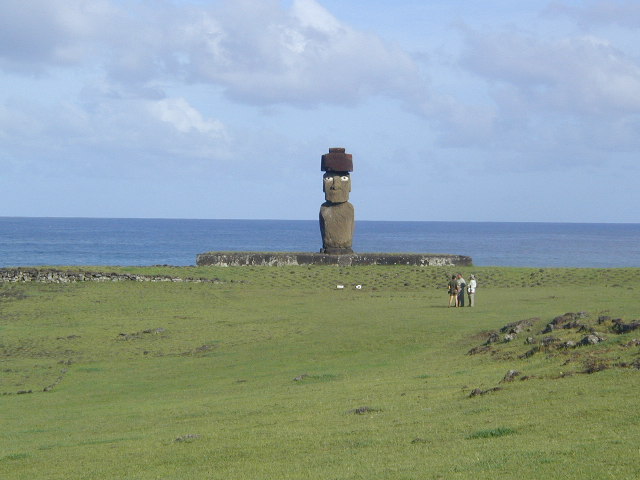
By the way, there was a 900 passenger American cruise ship off the coast that day. We heard that they circled the island most of the day but were unable to land as the water was too rough. I can only guess how disappointed the passengers on the cruise must have been.
I spent the rest of the morning at the museum. It's a bit of a hike from central Hanga Roa, but worth the excursion. The displays are all in Spanish, but they will lend you a translation booklet in English . I'd have liked more objects and less text, but I still found it very informative. There's a library behind the museum which had a photo exhibit (on a computer), as well as lots of books and magazines about Rapa Nui to look through.
Back in the center of town, I had lunch and did some crafts shopping. There are beautiful carvings, but many of them are pricy. For example, one of the characteristic figures is called a moai kavakava, which literally means a "statue of ribs." This is a stylized piece, with prominent ribs and genitals. I saw a fabulous moai kavakava that I would have loved to buy, but it was mahogany and cost over six hundred dollars. I settled for a much smaller carving that was an order of magnitude cheaper
In the evening, I went to one more festival event. This was a sort of historic reenactment. As far as I could tell, most of it had to do with two clans throwing spears at a palm tree until somebody got killed in the process. I'm sure this was all very culturally significant. But the narration was entirely in rapa nui and I didn't get much out of it, so didn't stay very long.
I didn't do anything much with my final morning on Rapa Nui - just another short walk around Hanga Roa. All in all, I'd say I had just about the right amount of time on Rapa Nui, allowing for a good overview of the island. My flight back to Santiago was in the early afternoon and was fairly empty. Since I was leaving Santiago again early in the morning, I'd reserved a room at the Diego de Almagro airport hotel. It wouldn't make any sense to stay there if you were going to spend time in the city, but it's a very nice modern hotel and was a good choice under the circumstances. They even open the hotel restaurant at 4 a.m. for breakfast, which is very convenient for people with early flights. And, indeed, I had an early flight the next morning, leading to the next chapter.
[ Back to Previous Chapter | Back to Index | On to Next Chapter ]
last updated 1 March 2007